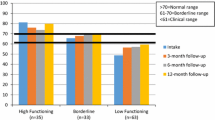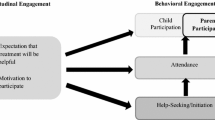Abstract
Measuring a program's success in enabling a child to improve functioning at home, school, and the community requires careful tracking of children's progress during the intervention and after it is completed. Attrition is often a major problem in carrying out longitudinal research. I present a number of strategies for maintaining high rates of response in follow-up studies, including how to choose a study design that enhances participation, how to locate study participants, how to engage study participants, and how to select and train high quality interviewers. The strategies presented have been used with success by a children's mental health agency and may be helpful to other researchers as they evaluate programs, measure outcomes, and study the life course of children with mental illness.
Similar content being viewed by others
REFERENCES
Achenbach, T. M. (1991). Manual for child behavior checklist. Burlington, VT: Dept. of Psychiatry, University of Vermont.
Cook, T. D. & Campbell, D. T. (1979). Quasi-experimentation: Design and analysis issues for field settings. Chicago: Rand-McNally.
Coyne, L. (1991). Follow-up study methodology: The Menninger project and a proposed ideal study. In S. M. Mirin, J. T. Gossett, & M. C. Grobs (Eds.), Psychiatric treatment: Advances in outcome research (pp. 2–14). Washington, DC: American Psychiatric Press.
Davis, M., & Vander Stoep A. (1997). The transition to adulthood for youth who have serious emotional disturbance, Part I: Developmental transition and young adult outcomes. Journal of Mental Health Administration, 24, 400–427.
Ellsworth, R. B. (1975). Consumer feedback in measuring the effectiveness of mental health programs. In M. Grittentag & E. L. Struening (Eds.), Handbook of evaluation research, vol. 2; (pp. 239–274). Beverly Hills, CA: Sage Publications.
Greenbaum, P. E., Dedrick, R. F., & Brown, E. C. (1997, February). Changes in problem and adaptive behavior: A growth curve analysis. Paper presented at the 10th Annual Research Conference: A System of Care for Children's Mental Health: Expanding the Research Base, Tampa, FL.
Greenbaum, P. E., Dedrick, R. F., Friedman, R. M., Kutash, K., Brown, E.C., Lardieri, S.P., & Pugh, A.M. (1996). National adolescent and child treatment study (NACTS): Outcomes for children with serious emotional and behavioral disturbance. Journal of Emotional and Behavioral Disorders, 4, 130–146.
Melville, E. & Vander Stoep, A. (1987, May). Transition to adulthood: The psychiatrically impaired adolescents. Paper presented at the 34th Annual Meeting of the American Academy of Child and Adolescent Psychiatry, Washington D.C.
Mental Health Division, State of Oregon. (1981). Training Manual for the Oregon Quality of Life Questionnaire (NIMH Contract #OP79-0053). Salem, OR: Department of Human Resources.
Mirin, S. M. & Namerow, M. J. (1991). Why study treatment outcome? In S. M. Mirin, J. T. Gossett, & M. C. Grob (Eds.), Psychiatric treatment: Advances in outcome research (pp. 2–14). Washington, DC: American Psychiatric Press.
Pfeiffer, S. I. (1989). Follow up of children and adolescents treated in psychiatric facilities: A methodology review. The Psychiatric Hospital, 20, 15–20.
Pfieffer, S. I. & Strzelecki, S. C. (1990). Inpatient psychiatric treatment of children and adolescents: A review of outcome studies. Journal of the American Academy of Child and Adolescent Psychiatry, 29, 847–853.
Pottick, K. J. & Lerman, P. (1991). Maximizing survey response rates for hard-to-reach inner-city populations. Social Science Quarterly, 72, 172–180.
Robins, L. N. (1966). Deviant children grown up: A sociological and psychiatric study of sociopathic personality. Baltimore, MD: Williams and Wilkins.
Silver, S. E., Duchnowski, A.J., Kutash, K., Friedman, R. M., Eisen, M., Prange, M. E., Brandenburg, N. A., & Greenbaum, P. E. (1992). A comparison of children with Serious Emotional Disturbance served in residential and school settings. Journal of Child and Family Studies; 1: 43–59.
Vander Stoep, A. (1990). Transition to adulthood for severely psychiatrically impaired youth. Paper presented at 118th Annual Meeting of the American Public Health Association, New York, City, NY.
Vander Stoep, A. (1991). Through the cracks: Transition to adulthood for severely psychiatrically impaired youth. Proceedings of the 4th Annual Conference sponsored by The Research Training for Children's Mental Health, University of South Florida, Tampa, FL.
Vander Stoep, A. & Blanchard, T. (1992, March). Introduction of mental health case management to homeless youth in King County, Washington. In K. Kutash, C. Liberton, A. Algarin & R. Friedman (Ed.), Fifth Annual Research Conference Proceedings: A System of Care for Children's Mental Health: Expanding the research base. (pp. 337–346). Tampa, FL: Florida Mental Health Institute, University of South Florida.
Vander Stoep, A., Taub, J., & Holcomb, L. (1993, March). Follow-up of adolescents with severe psychiatric impairment into young adulthood. In C. Liberton, K. Kutash & R. Friedman (Ed.), Sixth Annual Research Conference Proceedings: A System of Care for Children's Mental Health: Expanding the research base. (pp. 373–379). Tampa, FL: Florida Mental Health Institute, University of South Florida.
Vander Stoep, A. Telzrow, S. & Prentice, T. (1992, March). Longitudinal follow-up of children discharged from day treatment. Paper presented at 5th Annual Research Conference sponsored by The Research and Training Center for Children's Mental Health, University of South Florida, Tampa, FL.
Wagner, M. (1995). Outcomes of youths with serious emotional disturbance in secondary school and early adulthood. The future of children: Critical issues for children and youths, 5, 90–112.
Wagner, M., Newman, L., D'Amico, R. (1991). Youth with disabilities: How are they doing? Melo Park, CA: SRI International.
Author information
Authors and Affiliations
Corresponding author
Rights and permissions
About this article
Cite this article
Stoep, A.V. Maintaining High Subject Retention in Follow-Up Studies of Children with Mental Illness. Journal of Child and Family Studies 8, 305–318 (1999). https://doi.org/10.1023/A:1022015312913
Issue Date:
DOI: https://doi.org/10.1023/A:1022015312913




